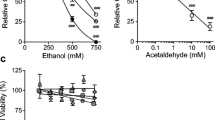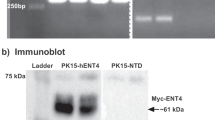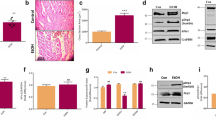Abstract
The adenosine transporter 1 (ENT1) transports nucleosides, such as adenosine, and cytotoxic nucleoside analog drugs. ENT1 is well established to play a role in adenosinergic signaling in the cardiovascular system by modulating adenosine levels. Moderate ethanol consumption is cardioprotective and underlying mechanisms of action are not clear although adenosinergic signaling has been implicated. Here, we show that ethanol (5–200 mM) significantly reduces ENT1-dependent [3H] 2-chloroadenosine uptake (by up to 27 %) in the cardiomyocyte cell line, HL-1. Inhibition or absence of ENT1 is known to be cardioprotective, suggesting that the interaction of ethanol with ENT1 may promote adenosinergic cardioprotective pathways in the cardiovasculature.
Ethanol sensitivity of adenosine uptake is altered by pharmacological activation of PKA and PKC. Primary cardiomyocytes from PKCε-null mice have significantly greater sensitivity to inhibition (by approximately 37 %) of adenosine uptake by ethanol than controls. These data suggest that the presence of ethanol may compromise ENT1-dependent nucleoside analog drug cytotoxicity, and indeed, ethanol (5 mM) reduces the cytotoxic effects of gemcitabine (2 nM), an anti-cancer drug, in the human cancer cell line, HTB2. Thus, the pharmacological inhibition of ENT1 by ethanol may contribute to ethanol-dependent cardioprotection but compromise gemcitabine cytotoxicity.







Similar content being viewed by others
References
Loffler M, Morote-Garcia JC, Eltzschig SA, Coe IR, Eltzschig HK (2007) Physiological roles of vascular nucleoside transporters. Arterioscler Thromb Vasc Biol 27(5):1004–13
Cano-Soldado P, Pastor-Anglada M (2012) Transporters that translocate nucleosides and structural similar drugs: structural requirements for substrate recognition. Med Res Rev 32(2):428–57
Rose JB, Naydenova Z, Bang A, Eguchi M, Sweeney G, Choi DS, Hammond JR, Coe IR (2010) Equilibrative nucleoside transporter 1 plays an essential role in cardioprotection. Am J Physiol Heart Circ Physiol 298(3):H771–7
Rose JB, Naydenova Z, Bang A, Ramadan A, Klawitter J, Schram K, Sweeney G, Grenz A, Eltzschig HK, Hammond J, Choi DS, Coe IR (2011) Absence of equilibrative nucleoside transporter 1 in ENT1 knockout mice leads to altered nucleoside levels following hypoxic challenge. Life Sci 89(17–18):621–30
Chaudary N, Shuralyova I, Liron T, Sweeney G, Coe IR (2002) Transport characteristics of HL-1 cells: a new model for the study of adenosine physiology in cardiomyocytes. Biochem Cell Biol 8:655–665
Chaudary N, Naydenova Z, Shuralyova I, Coe IR (2004) Hypoxia regulates the adenosine transporter, mENT1, in the murine cardiomyocyte cell line, HL-1. Cardiovasc Res 61(4):780–8
Chaudary N, Naydenova Z, Shuralyova I, Coe IR (2004) The adenosine transporter, mENT1, is a target for adenosine receptor signaling and protein kinase C epsilon in hypoxic and pharmacological preconditioning in the mouse cardiomyocyte cell line, HL-1. J Pharmacol Exp Ther 310(3):1190–8
Krauss SW, Ghirnikar RB, Diamond I, Gordon AS (1993) Inhibition of adenosine uptake by ethanol is specific for one class of nucleoside transporters. Mol Pharmacol 44(5):1021–6
Nagy LE (1992) Ethanol metabolism and inhibition of nucleoside uptake lead to increased extracellular adenosine in hepatocytes. Am J Physiol 262(5 Pt 1):C1175–80
Acevedo CG, Huambachano A, Perez E, Rojas S, Bravo I, Conreras E (1997) Effect of ethanol on human placental transport and metabolism of adenosine. Placenta 18(5–6):387–92
Allen-Gipson DS, Jarrell JC, Bailey KL, Robinson JE, Kharbanda KK, Sisson JH, Wyatt TA (2009) Ethanol blocks adenosine uptake via inhibiting the nucleoside transport system in bronchial epithelial cells. Alcohol Clin Exp Res 33(5):791–8
Coe IR, Dohrman DP, Constantinescu A, Diamond I, Gordon AS (1996) Activation of cyclic AMP-dependent protein kinase reverses tolerance of a nucleoside transporter to ethanol. J Pharmacol Exp Ther 276(2):365–9
Coe IR, Yao L, Diamond I, Gordon AS (1996) The role of protein kinase C in cellular tolerance to ethanol. J Biol Chem 271(46):29468–72
Nagy LE, Diamond I, Casso DJ, Franklin C, Gordon AS (1990) Ethanol increases extracellular adenosine by inhibiting adenosine uptake via the nucleoside transporter. J Biol Chem 265(4):1946–51
Nagy LE, Diamond I, Collier K, Lopez L, Ullman B, Gordon AS (1989) Adenosine is required for ethanol-induced heterologous desensitization. Mol Pharmacol 36(5):744–8
Guiraud A, De Lorgeril M, Boucher F, Berthonneche C, Rakotovao A, de Leiris J (2004) Cardioprotective effect of chronic low dose ethanol drinking: insights into the concept of ethanol preconditioning. J Mol Cell Cardiol 36(4):561–6
Krenz M, Baines CP, Yang XM, Heusch G, Cohen MV, Downey JM (2001) Acute ethanol exposure fails to elicit preconditioning-like protection in situ rabbit hearts because of its continued presence during ischemia. J Am Coll Cardiol 37(2):601–7
Miyamae M, Diamond I, Weiner MW, Camacho SA, Figueredo VM (1997) Regular alcohol consumption mimics cardiac preconditioning by protecting against ischemia–reperfusion injury. Proc Natl Acad Sci U S A 94(7):3235–9
Nagy LE, Diamond I, Gordon AS (1991) cAMP-dependent protein kinase regulates inhibition of adenosine transport by ethanol. Mol Pharmacol 40(5):812–7
Khasar SG, Lin YH, Martin A, Dadgar J, McMahon T, Wang D, Hundle B, Aley KO, Isenberg W, McCarter G, Green PG, Hodge CW, Levine JD, Messing RO (1999) A novel nociceptor signalling pathway revealed in protein kinase C ε mutant mice. Neuron 24:253–260
Scherlies R (2011) The MTT assay as tool to evaluate and compare excipient toxicity in vitro on respiratory epithelial cells. Int J Pharm 411:98–105
Franks NP, Lieb WR (1985) Mapping of general anaesthetic target sites provide a molecular basis for cut-off effects. Nature 316(6026):349–51
Miyamae M, Rodriguez MM, Camacho SA, Diamond I, Mochly-Rosen D, Figueredo V (1998) Activation of epsilon protein kinase C correlates with a cardioprotective effect of regular ethanol consumption. Proc Natl Acad Sci U S A 95:8262–7
Eltzschig HK, Abdulla P, Hoffman E, Hamilton KE, Daniels D, Schönfeld C, Löffler M, Reyes G, Duszenko M, Karhausen J, Robinson A, Westerman KA, Coe IR, Colgan SP (2005) HIF-1-dependent repression of equilibrative nucleoside transporter (ENT) in hypoxia. J Exp Med 202(11):1493–505
Volonté C, D'Ambrosi N (2009) Membrane compartments and purinergic signalling: the purinome, a complex interplay among ligands, degrading enzymes, receptors and transporters. FEBS J 276(2):318–29
Grenz A, Bauerle JD, Dalton JH, Ridyard D, Badulak A, Tak E, McNamee EN, Clambey E, Moldovan R, Reyes G, Klawitter J, Ambler K, Magee K, Christians U, Brodsky KS, Ravid K, Choi DS, Wen J, Lukashev D, Blackburn MR, Osswald H, Coe IR, Nürnberg B, Haase VH, Xia Y, Sitkovsky M, Eltzschig HK (2012) Equilibrative nucleoside transporter 1 (ENT1) regulates postischemic blood flow during acute kidney injury in mice. J Clin Invest 122(2):693–710
Morote-Garcia JC, Rosenberger P, Nivillac NM, Coe IR, Eltzschig HK (2009) Hypoxia-inducible factor-dependent repression of equilibrative nucleoside transporter 2 attenuates mucosal inflammation during intestinal hypoxia. Gastroenterology 136(2):607–18
Ronksley PE, Brien SE, Turner BJ, Mukamal KJ, Ghali WA (2011) Association of alcohol consumption with selected cardiovascular disease outcomes: a systematic review and meta-analysis. BMJ 342:d671
Nam HW, Lee MR, Zhu Y, Wu J, Hinton DJ, Choi S, Kim T, Hammack N, Yin JC, Choi DS (2011) Type 1 equilibrative nucleoside transporter regulates ethanol drinking through accumbal N-methyl-D-aspartate receptor signaling. Biol Psychiatry 69(11):1043–51
Marvi M, Rose JB, Bang A, Moon BC, Pozeg Z, Ibrahim M, Peniston C, Coe IR (2010) Nucleoside transporter expression profiles in human cardiac tissue show striking individual variability with overall predominance of hENT1. Eur J Pharm Sci 41(5):685–91
Reyes G, Nivillac NM, Karim MZ, Desouza L, Siu KW, Coe IR (2011) The Equilibrative Nucleoside Transporter (ENT1) can be phosphorylated at multiple sites by PKC and PKA. Mol Membr Biol 28(6):412–26
Boumah CE, Hogue DL, Cass CE (1992) Expression of high levels of nitrobenzylthioinosine-sensitive nucleoside transport in cultured human choriocarcinoma (BeWo) cells. Biochem J 288(Pt 3):987–96
Coe I, Zhang Y, McKenzie T, Naydenova Z (2002) PKC regulation of the human equilibrative nucleoside transporter, hENT1. FEBS Lett 517(1–3):201–5
Acknowledgments
This work was supported by the Canadian Institutes of Health Research and Natural Sciences and Engineering Council (Canada).
Author information
Authors and Affiliations
Corresponding author
Rights and permissions
About this article
Cite this article
Ramadan, A., Naydenova, Z., Stevanovic, K. et al. The adenosine transporter, ENT1, in cardiomyocytes is sensitive to inhibition by ethanol in a kinase-dependent manner: implications for ethanol-dependent cardioprotection and nucleoside analog drug cytotoxicity. Purinergic Signalling 10, 305–312 (2014). https://doi.org/10.1007/s11302-013-9391-2
Received:
Accepted:
Published:
Issue Date:
DOI: https://doi.org/10.1007/s11302-013-9391-2




